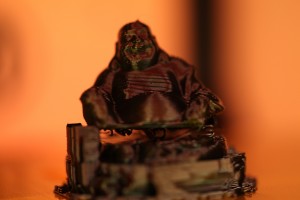Announcing the newest edition to the Media Center: our new NextEngine 3D scanner! To complement the Makerbot 3D printer, we now have the capability to produce high definition 3D meshes of small objects within around two hours. The NextEngine software also allows us to export in the .stl format – a format that can be printed on the 3D printer – so in due time we should be able to scan an object and then immediately start turning out plastic copies. I like to think that it brings us just one step closer to having Star Trek replicators.
After running a few calibration and test runs, we decided that our first victim for scanning and subsequent replication would be this miniature Buddha figurine. The scanner uses the combination of a camera and an array of lasers to scan objects, meaning that the easiest objects to scan aren’t too dark, light or shiny, and of course finer details and textures are harder to pick up. Ignoring that advice completely, we went ahead and scanned the Buddha figure.
Scans take about an hour to two hours to complete depending on the detail of the scan – for the Buddha, I used two 360° scans, one at a 0° tilt and one a around a 20° positive tilt to get some of the details on top of Buddhas hands and arms. Each 360° scan family consists of six to sixteen rotations – for this one I used twelve. Once the scans are complete, the software patches them together into a single 3D model, but sometimes it needs a little manual adjustment to get it just perfect.
After some toying with the scans on the NextEngine software we went ahead and printed a copy of Buddha on the Makerbot! Now I would draw your attention to the surprising level of detail on Buddha 2.0’s upper body, and not the fact that his lower half is slightly completely mutilated. Then again, we learned the importance of insuring that there are no holes in the 3D mesh or Makerbot kind of freaks out. Now, we think we’ve figured out a method for getting a 3D scan that is watertight and should produce printings that aren’t bisected.









